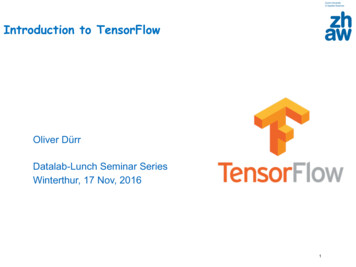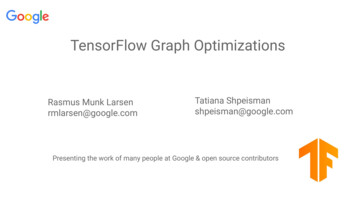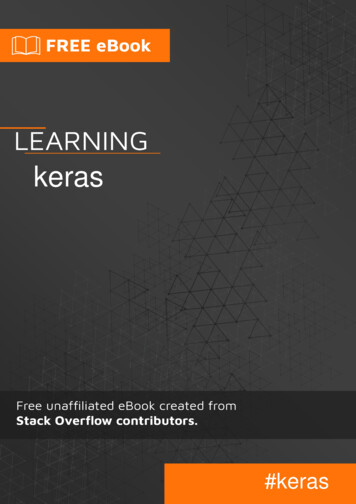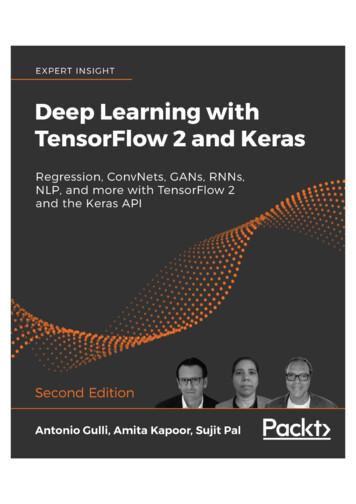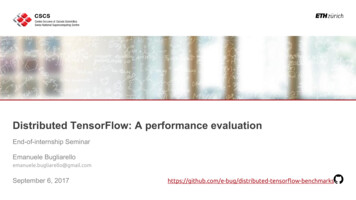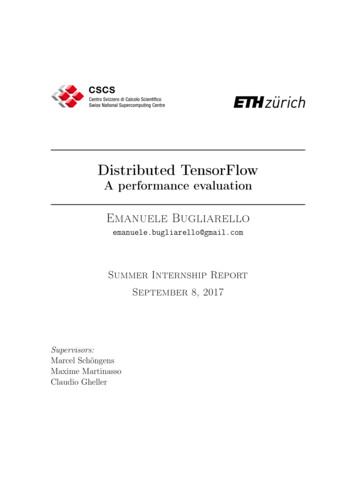
Transcription
Distributed TensorFlowA performance evaluationEmanuele Bugliarelloemanuele.bugliarello@gmail.comSummer Internship ReportSeptember 8, 2017Supervisors:Marcel SchöngensMaxime MartinassoClaudio Gheller
Distributed TensorFlow: A performance evaluationPage 1 of 25Contents1 Introduction22 TensorFlow2.1 Distributed training . . . . . . . . . . . . . . . . . . . . . . . . . . . .2.1.1 Load Balancing . . . . . . . . . . . . . . . . . . . . . . . . . .3683 Environments113.1 Local workstation . . . . . . . . . . . . . . . . . . . . . . . . . . . . . 113.2 Piz Daint . . . . . . . . . . . . . . . . . . . . . . . . . . . . . . . . . 113.3 AWS EC2 . . . . . . . . . . . . . . . . . . . . . . . . . . . . . . . . . 124 Distributed TensorFlow4.1 Local workstation . . .4.2 Piz Daint . . . . . . .4.3 AWS EC2 . . . . . . .4.4 Case Study: MNIST .5 Benchmarking Distributed Training5.1 Methodology . . . . . . . . . . . . . . . . . . . .5.2 Systems . . . . . . . . . . . . . . . . . . . . . . .5.3 Results . . . . . . . . . . . . . . . . . . . . . . . .5.3.1 Training with NVIDIA Tesla P100 . . . .5.3.2 Training with NVIDIA Tesla K80 . . . . .5.3.3 Distributed training on Piz Daint . . . . .5.3.4 Distributed training on Amazon p2.xlarge5.3.5 Distributed training on Amazon p2.8xlarge5.3.6 I/O overhead . . . . . . . . . . . . . . . .6 Conclusion and Future Work.1313131415.1616161717181920222324
Distributed TensorFlow: A performance evaluation1Page 2 of 25IntroductionIn the past few years, deep neural networks have made breakthroughs in a widevariety of everyday technologies, such as speech-recognition on our smartphones,machine translation and in image recognition. The success of deep learning is builtupon the availability of a vast volume of data and as their sizes grow larger, it cantake weeks to train deeper neural networks to the desired accuracy. Fortunately, weare not restricted to a single machine and research has been conducted on enablingefficient distributed training of neural networks.There are dozens of open source machine learning libraries that can be used todevelop deep learning applications. Here, we focus on TensorFlow, Google’s opensource machine learning framework. There are two main reasons why we analyzeTensorFlow: first, TensorFlow offers a flexible architecture allows you to deploycomputation to one or more CPUs or GPUs in a desktop, server, or mobile devicewith a single API. Second, most CSCS clients use TensorFlow as their deep learningframework.In this report, we analyze the performance of distributed training in TensorFlow (interms of number of images trained per second) in different systems and compare ourresults with the benchmarks available in TensorFlow’s website.The remainder of this report is organized as follows. We first give a brief overview ofTensorFlow, present its architecture in distributed training and explain how to easilyextend existing single-machine code to run on multiple nodes. We then introducethe systems on which we will run our benchmarks and give some pointers on how toset them up. Next, we describe the scripts we have written to easily run TensorFlowin a distributed environment, with a focus on Piz Daint which runs with SlurmWorkload Manager. A case study on MNIST is presented to show how to extenda single-node TensorFlow application to run across multiple nodes. After that, wedetail our methodology and discuss the results that we obtain when scaling out to128 GPUs. Finally, we present directions for future work and conclude this report.
Distributed TensorFlow: A performance evaluation2Page 3 of 25TensorFlowTensorFlow [9] is an open source software library for numerical computation usingdata flow graphs. Nodes in these graphs represent mathematical operations, whilemultidimensional arrays (tensors) move across the edges between them; hence thename. An example of a computational graph is shown in Figure 1.Figure 1: Computational graph for a regularized Multiclass SVM loss [3].In TensorFlow, you firstly build the computational graph and then run instancesof that graph. By doing so, the graph is created only once and the framework canapply some optimizations for you before it runs.To make this more concrete, let’s consider the linear regression example describedin Figure 2. The corresponding TensorFlow code is shown in Listing 1.f w*x bL (y - y pred)²x* y predquadraticlossLwbyFigure 2: Linear regression computational graph.25
Distributed TensorFlow: A performance evaluation1import numpy as np2import tensorflow as tfPage 4 of 2534# #5#6# #LOAD DATA10# Generate some data as y 3 x noiseN SAMPLES 10x in np.arange(N SAMPLES)y in 3 x in np.random.randn(N SAMPLES)11data list(zip(x in, y in))789#1213# #14#BUILD GRAPH#16# #simple graph tf.Graph()17with simple graph.as default():1518# Generate placeholders for input x and output y19x tf.placeholder(tf.float32, name ’x’)20y tf.placeholder(tf.float32, name ’y’)2122# Create weight and bias, initialized to 023w tf.Variable(0.0, name ’weight’)24b tf.Variable(0.0, name ’bias’)25# Build model to predict yy predicted x w b262728# Use the square error as the loss functionloss tf.square(y y predicted, name ’loss’)29303133# Use gradient descent to minimize lossoptimizer tf.train.GradientDescentOptimizer(learning rate 0.001)34train optimizer.minimize(loss)323536# #37#EXECUTE GRAPH#39# ## Run training for N EPOCHS epochs40N EPOCHS 538
Distributed TensorFlow: A performance evaluation414243Page 5 of 25with tf.Session(graph simple graph) as sess:# Initialize the necessary variables (w and b here)sess.run(tf.global variables initializer())444546# Train the modelfor i in range(N EPOCHS):total loss 0for x ,y in data:4748# Session runs train operation and fetches values of loss, l value sess.run([train, loss], feed dict {x: x , y: y })total loss l value495051print(’Epoch {0}: {1}’.format(i, total loss/N SAMPLES))52Listing 1: Linear regression in TensorFlow.In the previous snippet, when we build the data flow graph, every variable (suchas x, w, loss, and train) is not assigned any value but it is actually an operationthat is added to the graph. Specifically, a tf.placeholder represents a containerfor future values that will be loaded at run time, a tf.Variable instead representsa tensor that will be modified by the learning algorithm during the optimizationphase, while the other ones are mathematical operations, as shown in Figure 2.We start an execution by opening a tf.Session, to which we pass the graph definedbefore. Here, we firstly initialize our tf.Variables by assigning them their initialvalue, and then train our model for N EPOCHS epochs 1 by passing each time aninput and an output sample via feed dict in sess.run(). sess.run() evaluatesthe list of operations that are passed in its first argument. It does so by computingonly the nodes in the graph these operations depend on and returns their values atthe end of the evaluation.The resulting linear model is shown in Figure 3.1An epoch is one complete presentation of the training data set to a machine learning model.
Distributed TensorFlow: A performance evaluationPage 6 of 25Linear RegressionReal dataPredicted data2520y151050024x68Figure 3: Linear model learned with the example code in Listing 1.2.1Distributed trainingAs neural networks become larger, it can take weeks to train one of them to achievethe desired accuracy. It is then of primary importance to distribute the training ofthese deep neural networks at a massive scale and reduce the training time to hours.TensorFlow offers a large degree of flexibility in the placement of graph operations,allowing easy implementations for parallel computation across multiple workers.When splitting the training of a neural network across multiple nodes, the mostcommon strategy is data parallelism, where each node has an instance of the modeland reads different training samples.When using TensorFlow, this is achieved with the so-called “between-graph replication” setting. In this context, processes have one of two roles: Parameter Servers(PS) or Workers. The former ones host the trainable variables and update themwith the values sent by the Workers. Workers, on the other hand, run the model,send their local gradients to the PSs and receive the updated variables back.In doing so, it is essential that all the Workers send their updates of each variableto the same PSs. To ensure correct device placement of each variable, TensorFlowoffers replica device setter, which provides a deterministic method for variableallocation, ensuring that the variables reside on the same devices.
Distributed TensorFlow: A performance evaluationPage 7 of 25Given that each Worker runs the same model, the only high-level changes requiredin a parallel implementation are the definition of the cluster of nodes and the roleof each of them (Parameter Server/Worker). The following code snippet (from [4])shows how to specify such configuration in TensorFlow. Note that such a scriptwould be executed on each machine in the cluster, but with different arguments.1import sys2import tensorflow as tf34# Specify the cluster’s architecture5cluster tf.train.ClusterSpec({’ps’: [’192.168.1.1:1111’],6’worker’: 89101112# Parse command line to specify machinejob type sys.argv[1] # job type: "worker" or "ps"task idx sys.argv[2] # index job in the worker or ps list# as defined in the ClusterSpec13141516# Create TensorFlow Server. This is how the machines communicate.server tf.train.Server(cluster, job name job type, task index task idx)1718192021222324252627# Parameter server is updated by remote clients.# Will not proceed beyond this if statement.if job type ’ps’:server.join()else:# Workers onlywith tf.device(tf.train.replica device setter(worker device ’/job:worker/task:’ task idx,cluster cluster)):# Build your model here as if you only were using a single machine282930with tf.Session(server.target):# Train your model hereListing 2: Distributed TensorFlow skeleton.The first step in running distributed TensorFlow is to define the architecture of thecluster using tf.train.ClusterSpec, where the IP addresses and ports of all theprocesses for each role are provided.
Distributed TensorFlow: A performance evaluationPage 8 of 25Next, the script determines its job type (or role) and its index among all the processes with the same job type. This is typically achieved by passing command-linearguments to the script, which are then parsed. Here, job type specifies whetherthe node is running a Parameter Server or a Worker task, whereas task idx specifies the process’s index into its task list. An important remark regarding task idxis that the list of nodes per role is interpreted as a sorted array. That is, you cannotarbitrarily set the task idx of a given process; instead, this must reflect the positionof that process in the original PS or Worker list specified in tf.train.ClusterSpec.For instance, the script for Worker 192.168.1.2:1111 must be launched setting itstask idx to 0 as it is the first Worker in the list.The next step is to use this information to create a TensorFlow Server, which allowsthis process to communicate with any other server in the same cluster and participate in distributed training.If the node is a Parameter Server, it simply joins its threads and waits for them toterminate. While it may seem counterintuitive that there is no PS-specific code, thegraph elements are actually pushed to it from the workers.Conversely, if the device is a Worker, we use replica device setter to build ourmodel, so that parameters are consistently allocated across our Parameter Servers.Finally, a tf.Session is created and the model is trained.A valuable note is that Parameter Servers and Workers may coexist on the samemachine. This is actually the recommended choice, especially when GPU-enablednodes are available. In this case, Parameter Servers would run on CPUs and Workerson GPUs, as their workload is much heavier. By doing so, not only do we reduce thenumber of nodes required to run a given application, but also minimize the amountof traffic generated in the network, resulting in higher performance.2.1.1Load BalancingIn a distributed environment, it is of importance that each Worker has available theupdates obtained by the other Workers in order to train faster. This leads to theneed of tackling how to place the variables.TensorFlow’s tf.device function allows to specify where each operation is storedby means of a device string passed as its argument. The following snippet of codegives an example of how this is done.
Distributed TensorFlow: A performance evaluation123with tf.device("/job:ps/task:0/cpu:0"):weights 1 tf.get variable(’weights 1’, [784, 100])biases 1 tf.get variable(’biases 1’, [100])6with tf.device("/job:ps/task:1/cpu:0"):weights 2 tf.get variable(’weights 2’, [100, 10])biases 2 tf.get variable(’biases 2’, [10])7with tf.device("/job:worker/task:0/gpu:0"):458Page 9 of 25# Build your model hereListing 3: Variable placement with device strings.Here, we ask for weights 1 and biases 1 to be placed in the first PS, whileweights 2 and biases 2 in the second one. Then, each worker designates itselfin the third with block in the case of “between-graph replication”.However, it may be difficult to specify where each variable is hosted, especially ifmany Parameter Servers are desirable for an application in order to distribute thework of updating the variables or distribute the networking load for fetching themto the Workers. So, TensorFlow allows to pass a device function instead of a devicestring to tf.device, with the aim of setting a more sophisticated placement strategy.Some of such functions are already embedded in TensorFlow. The simplest of themis called tf.train.replica device setter, which assigns variables to the Parameter Servers in a round-robin fashion as they are created. A nice property of thisdevice function is that it allows to write all the code to build a model in a single withblock. In fact, this only affects the variables, putting them in different ParameterServers, while the rest of the operations in the graph go on Workers, simplifying“between-graph replication” parallelism.The following snippet gives an example of using this function and the resultingvariable placement is shown in Figure 4 under the round-robin case.12with tf.device(tf.train.replica device setter(ps tasks 3)):weights 1 tf.get variable(’weights 1’, [784, 100])5biases 1 tf.get variable(’biases 1’, [100])weights 2 tf.get variable(’weights 2’, [100, 10])biases 2 tf.get variable(’biases 2’, [10])6# Build your model here34Listing 4: Default variable placement with replica device setter.
Distributed TensorFlow: A performance evaluationPage 10 of 25Round-robin variables/job:ps/task:0weights 1/job:ps/task:1biases 1/job:ps/task:2weights 2biases 2Load balancing variables/job:ps/task:0weights 1/job:ps/task:1biases 1/job:ps/task:2weights 2biases 2Figure 4: Round-robin (default) and greedy load balancing variable placement withreplica device setter.For this example, Figure 4 shows that weights 1 would go to the first ParameterServer, biases 1 would go to the second Parameter Server, weights 2 would beput on the third Parameter Server and biases 2 back on the first Parameter Server.This is obviously not a balance load for these variables, neither in terms of the memory usage nor in terms of the work to be done to update these variables.Moreover, if only two Parameter Servers were used here, we would end up in aneven worse case where all the weights would go on the first Parameter Server andall the biases on the second one, giving an even bigger imbalance between these tasks.To achieve a more balance load, TensorFlow allows to specify a load balancingstrategy in tf.train.replica device setter as an optional argument.The only one currently available is a simple greedy strategy that does a kind of onlinebin packing based on the number of bytes of the parameters, giving a more balancedoutcome as shown under load balancing variables in Figure 4 for our example.1234567greedy with tf.device(tf.train.replica device setter(ps tasks 3,ps strategy greedy)):weights 1 tf.get variable(’weights 1’, [784, 100])biases 1 tf.get variable(’biases 1’, [100])weights 2 tf.get variable(’weights 2’, [100, 10])biases 2 tf.get variable(’biases 2’, [10])Listing 5: Greedy load balancing variable placement with replica device setter.
Distributed TensorFlow: A performance evaluation3Page 11 of 25EnvironmentsIn this section, we introduce all the systems which have been used to test and runTensorFlow applications and how to set them up.The version of TensorFlow that we chose is 1.1.0 in order to compare our resultswith other benchmarks available online.The code for this section can be found in the environments setup folder of ourrepository.3.1Local workstationWith local workstation we mean a device, such as a laptop, which usually does nothave much compute power. This can be used to just test whether an applicationworks, even in a distribute setting if it possesses multiple CPUs and/or GPUs.Follow the instructions on the GitHub page to install TensorFlow and create a virtualenvironment.3.2Piz DaintPiz Daint is a hybrid Cray XC40/XC50 supercomputer at CSCS. The system hasAries routing and communications ASIC, with Dragonfly network topology.At the time of writing, it is the third most powerful supercomputer in the world [12]and in the top ten of the most energy-efficient supercomputers [6].Each node that we use in Piz Daint is equipped with an NVIDIA Tesla P100 [8].We use the TensorFlow 1.1.0 module available in Piz Daint whenever we run anapplication.The instructions in the GitHub page show how to create a virtual environmentcontaining all the requirements needed to also run Jupyter notebooks (provided alocal workstation has already been set up and its pip requirements are available).
Distributed TensorFlow: A performance evaluation3.3Page 12 of 25AWS EC2We also use Amazon EC2 instances [5] to compare the speedup achieved on PizDaint with the virtual servers available in the cloud of one of the most popular webservices.There are many types of virtual servers, also known as compute instances, to choosefrom [1]. For our comparisons, we make use of P2 instances, intended for generalpurpose GPU compute applications. In particular, we use p2.xlarge (1 GPU pernode) and p2.8xlarge (8 GPUs per node) models.AWS.md (in the repository folder) contains additional information on how to createEC2 instances, Amazon S3 [2] buckets (object storage) and how to transfer datafrom/to S3.The instructions in the README file illustrate how to set up each instance to runTensorFlow 1.1.0. To do so, NVIDIA cuDNN [7] is required. In our case, we retrieveit from Piz Daint.The only inputs required for the setup of all the machines are their IP addresses,both public and private ones 2 . Hence, you can simply launch compute instancesvia the AWS management console and copy their IP addresses, one per line, inaws public ips.txt and aws private ips.txt under the repository’s root directory, without leaving any empty lines.2We need the instances’ private IP addresses in order to avoid sending each packet through anadditional hop, which would considerably reduce performance.
Distributed TensorFlow: A performance evaluation4Page 13 of 25Distributed TensorFlowWe now describe how to launch a script written to use distributed TensorFlow (seeSection 2.1) in each of the environments introduced in the previous section.The code for this section can be found in the distributed tensorflow launchersfolder of our repository.4.1Local workstationThe setup script for the local workstation runs each task (PS or Worker) on a different terminal window. By default, Parameter Servers are launched starting at port2230, while Workers at 2220. The script calls, for each task, run dist tf local.sh.This script then runs the (distributed TensorFlow) Python script defined herein,with the flags specified in this file as well, for its corresponding task.4.2Piz DaintIn the setup script for Piz Daint, we firstly set options for Slurm and load the TensorFlow module. Then, we define the (distributed TensorFlow) Python script to beexecuted and its flags. Finally, we set the number of Parameter Servers and Workers.These values must be consistent with the number of nodes requested for the job. Inparticular, if the Parameter Servers run in a (sub)set of the Worker nodes 3 (defaultbehavior), then the number of Workers must not exceed the number of allocatednodes. On the other hand, if the PSs need to run on different nodes than the Workers, then the total number of tasks must not exceed the number of allocated nodes.In case the number of allocated nodes is not enough, an error message is returned.Other settings for a distribute run (commented in the setup script) can be tuned.This script then calls run dist tf daint.sh with the settings declared, which runsthe Python script in a distribute environment as described in the next paragraph.run dist tf daint.sh runs the Python script that exported in the setup file.Firstly, the script checks which configuration parameters have been set by the userin the setup file. The only necessary information needed is the name of the Python3We assume that the number of Workers is always greater than or equal to the number of PSs.
Distributed TensorFlow: A performance evaluationPage 14 of 25script. The number of Parameter Servers defaults to 1, while the number of Workersdefaults to the number of allocated nodes. If not set in the setup file, the script alsoassumes to run one Worker per node and at one Parameter Server. Note that itis not possible to run multiple Workers on a single node in Piz Daint if you usethe GPU partition as multiple TensorFlow tasks cannot share the same device. Asmentioned above, if multiple Parameter Servers are set, the script’s default is to runthem in a (sub)set of the nodes running a Worker task. This is possible becauseWorker’s operations run in the GPU, while Parameter Servers run in the CPU.The script then retrieves which nodes have been assigned to the job and creates twocomma-separated lists: one indicating Parameter Server hosts and one indicatingWorker hosts. For each node, PSs start at port 2230, while Workers at port 2220.After that, for each node, the script determines how many PSs and Workers are tobe run in that node, and creates a Bash script to launch Parameter Server and/orWorker processes. When creating these Bash scripts, if a Parameter Server is tobe launched, then it is necessary to hide the GPU to avoid that the PS runs on it;which would result in the Worker running on the CPU.The need of a Bash script is justified by the fact that you can only have a singlesrun execution per node. So, we just run each process in background (appending &at the end of the command) but the last one.4.3AWS EC2The setup script for Amazon EC2 instances runs remotely; i.e. from a local workstation, for instance. It launches one or multiple tasks for each node, according to thenumber of PSs and Workers entered. Parameter Servers always run in nodes runningWorker tasks as well. The only inputs to the setup script are the IP addresses ofthe instances, the path of the private key you use to log into them and the numberof PSs and Workers. In detail, a screen session is started for each task.Parameter Servers’ ports start from 2230 at each node, while Workers’ from 2220.It is necessary that private and public IP addresses correspond to the same EC2instance in the two IP files. That is, the private IP address in line 1 of the privateIP addresses file must be the private address of the instance whose public IP addressis in line 1 in the public IP addresses file. Private IP addresses are requested in orderto reduce the number of hops between two nodes, achieving higher performance.run dist tf aws.sh, instead, has to be copied in each EC2 instance, along withthe (distributed TensorFlow) Python script. When called from the setup file, thisscript firstly hides the GPUs from the Python application if the launched task is aParameter Server (to the Workers to use them) and then runs the application.
Distributed TensorFlow: A performance evaluation4.4Page 15 of 25Case Study: MNISTThe MNIST folder of our repository contains an application of the scripts describedabove for a local workstation and Piz Daint.DeepMNIST.ipynb and deepMNIST.py contain the code of the original deep MNISTtutorial available in TensorFlow’s website, which consists of a three-layer neuralnetwork (two convolutional layers followed by a fully-connected layer) to classifyhandwritten digits.We then provide a GPU-enhanced version of this network (deepMNIST gpu.py).As described in TensorFlow’s High-Performance Models page, one of the best practices to improve performance and increase flexibility of a model is to add the supportfor the data format. In fact, most TensorFlow operations used by a CNN supportboth NHWC and NCHW image data formats. Image data format refers to the representation of batches of images. TensorFlow supports NHWC (TensorFlow default)and NCHW (cuDNN default). N refers to the number of images in a batch, H refersto the number of pixels in the vertical dimension, W refers to the number of pixels inthe horizontal dimension, and C refers to the channels (e.g. 1 for black and white,3 for RGB, etc.). Although cuDNN can operate on both formats, it is faster tooperate in its default format. So, NCHW should always be used when training withGPUs, while NHWC is sometimes faster on CPUs. By adding data formats to anapplication, it is then possible to train using NCHW on GPU, and then do inferencewith NHWC on CPU.In order to make the existing application support NCHW data format, we introducesome if statements that allow to swap the order of the elements in the kernel size andstrides arrays in the pooling layers. Moreover, we also use the optional data formatargument of the tf.nn.conv2d function to let the specified image data format beingused in convolutions.Finally, we apply the template shown in Listing 2 to train this GPU-enhanced versionof MNIST across multiple nodes in dist deepMNIST gpu.py. Here, only Worker 0evaluates test accuracy, while each Worker evaluates their train accuracy. To launchthis application, we used the setup and run dist tf scripts presented in this section.
Distributed TensorFlow: A performance evaluation5Page 16 of 25Benchmarking Distributed TrainingWe now present the scalability results relative to training InceptionV3 [16], a deepneural network by Google, on GPU-enabled nodes in Piz Daint and in Amazon EC2.To do so, we use Google’s script [10], which provides optimized implementations formultiple networks. The dataset used for training is ImageNet [14], one of the mostcommon datasets used for classification in Computer Vision.The code for this section can be found in the google-benchmarks folder of ourrepository.5.1MethodologyGoogle’s script allows to set different parameters, such as the batch size, the numberof warmup steps, the number of steps to be averaged, whether to use NVIDIA NCCLall-reduce primitives and the data layout format (NCHW or NHWC).The main output of this script is the average number of images per second thathave been trained in the system. In order to find a good ratio between the numberof Workers and the number of Parameter Servers, we try, for each configurationof number of Workers and number of nodes, several values for the number of PSsranging from 1 to the number of Workers. For each configuration, we then reportthe results achieving the largest number of images trained per second. In order toproduce results that are as repeatable as possible, each test was run 5 times andthen the times were averaged together, analogously to what Google did. GPUs arerun in their default state on all the platforms.For each test, 10 warmup steps are done and then the next 100 steps are averaged.We ran our benchmarks using both real and synthetic data 4 , so that we can evaluateboth the compute and the input pipelines.5.2SystemsWe run benchmarks on Piz Daint, as well as on p2.xlarge and p2.8xlarge AmazonEC2 instances. Whenever possible, we compare our results with the ones published4By synthetic data we mean fake data that has almost the same properties as the real one.
Distributed TensorFlow: A performance evaluationPage 17 of 25by Google [11], obtained with NVIDIA DGX-1 and Amazon p2.8xlarge systems.Piz Daint and NVIDIA DGX-1 both have NVIDIA Tesla P100 GPUs, even thoughthe former only has one GPU per node, while the latter has 8 GPUs per node.Amazon p2.xlarge and p2.8xlarge EC2 instances, instead, are equipped with NVIDIATesla K80 GPUs. p2.xlarge instances have one GPU per node, while p2.8xlargeinstances have eight GPUs per node (four K80).5.3ResultsFor all of the reported results, the following settings are used: Model: InceptionV3 Batch size per GPU: 64 Data Format: NCHW Local Parameter Device: CPU Optimizer: sgd Piz Daint OS: Suse 12/CLE 6.0.UP02 AWS OS: Ubuntu 16.04 LTS CUDA/cuDNN: 8.0/5.1 TensorFlow: 1.1.0 Piz Daint Parallel File System: Lustre AWS D
Distributed TensorFlow: A performance evaluation Page8of25 Next, the script determines its job type (or role) a

